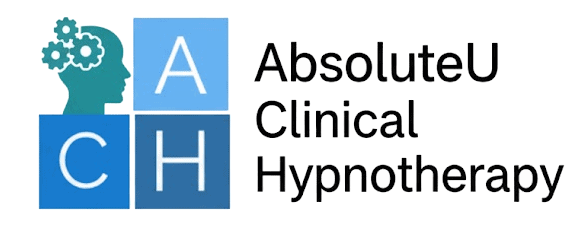CBT for Anxiety
When anxiety takes hold, it can feel as though your thoughts are running away from you. The mind becomes busy, replaying worries and fears on a loop. You might find yourself overanalysing every small detail, jumping to conclusions or trying to predict what might happen next. In these moments, you can feel trapped inside your own head, and your body often follows with symptoms such as tight muscles, shallow breathing or an increased heartbeat.
This is where CBT for anxiety can help. Cognitive Behavioural Therapy, or CBT, is a practical, structured way of retraining how your mind responds to anxious thoughts. Rather than trying to suppress them, CBT teaches you how to question, interrupt and replace unhelpful thought patterns with calmer, more realistic ones. By doing so, your body also begins to relax, and the sense of overwhelm starts to fade.

At AbsoluteU Clinical Hypnotherapy in Horsham, we often combine CBT for anxiety with hypnotherapy to address both the conscious and subconscious levels of the mind. These two approaches complement each other beautifully: CBT provides logical, step-by-step strategies for managing thoughts, while hypnotherapy helps embed new responses deep within the subconscious so they become automatic.
Understanding the Thought–Feeling Connection
Every thought has a corresponding emotional response. When you think something negative or threatening, the brain releases chemicals that trigger feelings of fear or stress. Your heart rate increases, breathing changes and muscles tighten, preparing your body for what it believes is danger. This automatic response, often referred to as the fight or flight reaction, is useful when facing real threats but can be overwhelming when it is triggered by imagined worries.
With CBT for anxiety, you learn to slow this process down. Instead of letting thoughts spiral into panic, you begin to notice them earlier, identify whether they are based on fact, and challenge their accuracy. Over time, this reduces the frequency and intensity of anxiety.
CBT Tip 1: The FACT Technique
One of the simplest and most effective ways to calm anxious thoughts is through the word FACT. When your mind becomes filled with what ifs and maybes, pause and ask yourself: “Is this a fact right now?” If there is no evidence to support the thought, label it as an assumption and let it go.
For example, you might think, “What if I fail this presentation?” If you have prepared and there is no factual reason to believe failure is certain, then the thought is not a fact, it is a fear. Dropping it quickly prevents your mind from spiralling into endless negative scenarios.
The more you use this technique, the faster your brain learns to separate facts from fiction. Over time, your subconscious adopts this process naturally, creating a calmer and more rational state of mind. It’s one of the cornerstones of CBT for anxiety, as it builds confidence and trust in your own ability to assess situations realistically.
CBT Tip 2: Thought Balloons
When your mind is full of anxious thoughts, it can feel overcrowded, as though every worry demands attention at once. Visualising these thoughts can help you regain control. Imagine each thought or fear as being contained within a balloon floating in your mind. See yourself slowly releasing or deflating these balloons, allowing space to open up.
This metaphorical exercise signals to your subconscious that you are in control of your mental space. The mind responds well to imagery, and by repeating this process, you can train yourself to let go of unnecessary tension. With practice, you will begin to notice moments of stillness and calm returning, even during stressful times.
In CBT for anxiety, visual tools like this are used to change how your brain perceives your thoughts. By giving them form, you stop them from feeling overwhelming and instead see them as temporary and manageable.
CBT Tip 3: Focusing on the Positives
The human brain naturally pays more attention to negatives than positives. It’s part of our evolutionary wiring, designed to keep us alert to potential danger. However, in modern life this bias often works against us, amplifying minor setbacks and overshadowing achievements.
To rebalance this, CBT for anxiety encourages you to consciously focus on the positives each day. Before bed, reflect on three things that went well, no matter how small. Perhaps you completed a task, enjoyed a conversation, or simply took time to rest.
By doing this consistently, you retrain your brain to seek out and register positive experiences. Over time, this builds resilience and increases confidence. Many people notice that they start to do this naturally throughout the day, silently acknowledging moments of calm or satisfaction.
This technique may sound simple, but it has powerful effects. It shifts your attention away from what went wrong towards what went right, which in turn reduces the emotional power of anxiety.
Combining CBT with Hypnotherapy
At AbsoluteU, we find that combining hypnotherapy with CBT for anxiety enhances results. Hypnotherapy accesses the subconscious mind where emotional responses are stored, while CBT addresses the conscious thinking patterns that maintain them. Together, they create lasting change from both directions.
During sessions, clients often experience deep relaxation while exploring new, positive ways of thinking. These experiences reinforce new habits, making calm and confidence the default state rather than anxiety and overthinking. The subconscious mind begins to respond to uncertainty with curiosity instead of fear.
This dual approach is especially effective for clients who struggle with racing thoughts or who have found it difficult to apply CBT techniques on their own. Hypnotherapy strengthens the connection between the body and mind, allowing new responses to feel more natural and automatic.
Building a Calmer Future
Learning CBT for anxiety is not about becoming a different person, but about teaching your mind to work with you rather than against you. Anxiety is often a sign that your mind is trying to protect you but has simply learned an unhelpful way to do it. Once you understand this, you can begin to retrain it gently, with patience and practice.
The techniques you learn can be applied to all areas of life. They help you think clearly at work, sleep better at night, and feel more confident in relationships and decision-making. By learning to manage your thoughts, you also change how your body feels, calmer, lighter and more balanced.
Anxiety does not have to control you. With the right guidance, your thoughts can become tools for focus rather than sources of fear. Each time you practise these techniques, you strengthen new pathways in your brain that support peace of mind.
If you would like to learn more about CBT for anxiety and how it can help you take control of your thoughts, contact AbsoluteU Clinical Hypnotherapy in Horsham. Sessions are available both online and in person, and a free initial consultation is offered to help you explore the best approach for your needs.

